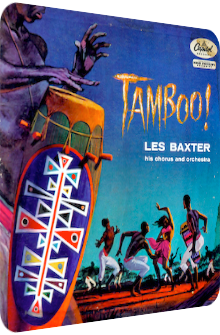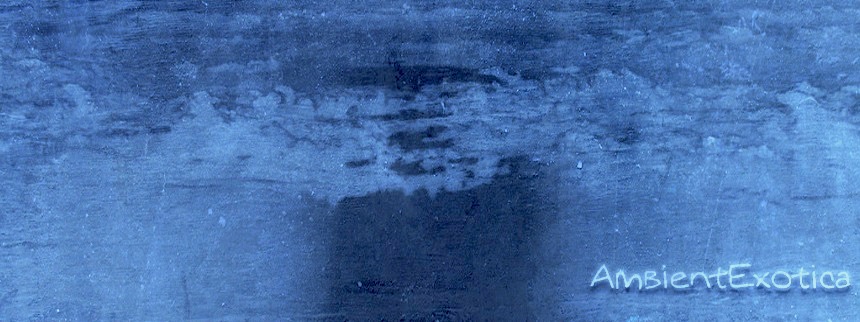
Les Baxter
Tamboo!
1956
Les Baxter's Tamboo! is another important pre-Exotica album, making him the Regent of a musical country that wasn't formed until 1957 with Martin Denny's Exotica record. Still, Baxter delivers a pitch-perfect rendition of entirely original Exotica tunes that soon became classics in the years following this release of 1956. Tamboo! contains the common 12 tracks and is a mixed bag in that it shuttles between several styles, moods and countries which can be considered a major flaw – see the final paragraph of this review for a more detailed exemplification.
Don't be scared away due to my spoilsport words, though! Baxter delivers melodious and even mysterious songs, and the audio quality is gorgeous. An important inclusion is the large choir that allows more efficient cinematic setups and majestic vistas. Another unexpected oddity is the restrictive use of many exotic instruments, primarily the sitar. You crave for more once you hear it, but all in all, it's featured less than 30 seconds on the whole album. And to the surprise of many listeners, Baxter includes one or two very soothing tunes that purposefully lack the pompousness and vividness found in the remaining tracks. Read about 10 songs off Tamboo! in the following paragraphs and about its rather dubious context in the last paragraph if you're interested in a minor excursion into music theory and history.
The first track is called Simba, and it immediately shows Baxter's approach of intermingling supposedly African percussion and a savage-like choir with Hollywood ingredients such as piano chords, brass backings, cascading harps and xylophone glints. However, the mood is far from ritualistic, but is rather jolly and cinematic. Only the last 20 seconds offer a change of pace with hectical congas and percussive bits.
Oasis Of Dakhla comes next and is a gorgeous song, even though it is not pompous or glitzy. Gently shaken maracas and a carefully humming choir make for an unexpectedly quiet and laid back song. A distinct flute plays in unison with reduced strings, and cascading harps add pompousness to the song. The last minute consists of fast rattles and a freely flowing flute melody. This is a perfect and rather unusual Baxter track to my mind, for the mood is never destroyed or altered by overly humongous instrument sections. The atmosphere is retained, and the song somehow does depict the setting of an oasis marvelously. If you prefer Baxter's string washes and percussive songs, you might find Oasis Of Dakhla rather dull. To me, it's exactly this non-clichéd, original approach that makes this song so effective.
Next is Maracaibo, and it's a Baxter song by the numbers with playful harp slaps, undermining trumpet bits, polyphonous piano additions and vividly shimmering string sections. All of these instruments paint a sunny scenery of the bustling port town, somewhat breaking the overarching concept shown on the front cover. Tehran is the next destination, and its Middle Eastern flavor is perceptible right from the beginning with a bass flute played in a mysterious style, accompanied by shaking tambourines. An effective addition are the slightly cacophonous piano and clarinet bits that further amplify the alienating soundscape for Baxter's contemporary listeners. The percussion increases in volume, deeply rumbling orchestra drums and muffled bongos enhance the tension, and the second-long inclusion of a sitar is far too short, as is the humming choir near the end.
Havana is a quickly-paced and lively rendition of the Cuban capitol, but don't expect a Latin approach, as Baxter's piece could be titled entirely differently, as the mood is totally independent of any Cuban spirit: Harp dots and wildly joyful string sections are the main ingredients of this song. Yet again the topos of Africa (as suggested on the frontcover) is further away than ever, but the song is vibrant and melodious.
Mozambique starts with rattles, arcane claves and backing bongos. A bass flute is playing fastly, but it is after almost 90 seconds when the song shifts boldly and changes the gentle percussion threefoldly, first by adding tempo to it, then by increasing the tempo once more for the second time. The result is a tribal percussion that is accompanied by gorgeous marimba bursts, xylophone sprinkles and the most beautiful harp melodies on the whole album. Finally, the percussion gets conga-driven and is taversed by glistening and reverberated marimba sections and a final section of majestic brass sounds. Mozambique offers basically 4 songs in 1, and all parts are clearly divided. Since this song is rather short, the sequence of these sections moves by too fast and is seemingly arbitrary, but on the other hand, the faux-African flavor is finally re-introduced.
Wotuka starts with the humming male choir and bongo percussion before a bright staccato melody with harps and xylophones is added. Quavering flutes and strings add majesty, as is the choir who is humming much higher then. Curiously, it is the last 12 seconds or so that are among the best of the album, with a terrifically droning dark piano note and additional bongos, delivering a good counterpart to brightly coruscating harps. Another song worth mentoning is Batumba, as it not just broadens the spectrum of the album by adding a curiously foggy and mysterious mood, but is also a distinctive entity in Baxter's exotic oeuvre. The flute force plays a remarkably gloomy melody, but the piano dots, harps and sitars dampen the mystique quite a bit. A song which is one of a kind, even by Baxter's standards. One of his greatest songs ever, absolutely catchy despite the omission of strings and the missing vocabulary for an adequate description.
Rio returns to sunny lands with its main focus on broad strings, brass backings, a rising tempo and jolly flute bits, while the final Zambezi is keen on using the choir to its fullest force. The melody is first hummed by the choir only, with only bongos and maracas accompanying it. Later, a flute takes over and orchestra bells underline the fanfarous mood. The second half of the song adds vivid percussion and a sky-high choir whose hummings are enhanced by brass sections. To my pleasure, the last 30 seconds consist of various percussive bits, ending the album on the tribal note that is promised by the cover.
Yes, the majority of Tamboo!'s songs is catchy, and the production is as flawless as the variety of instruments. And yet I have to nitpick certain presentation-related aspects: why do the album's liner notes put the drums into the limelight when they are clearly not the main ingredient – take Don Ralke's album The Savage And The Sensuous Bongos as a proper example where the drums are tremendously important. And why the insistence of delivering romantic songs when the results aren't romantic at all, apart from Oasis Of Dakhla, Maracaibo and Havana? If you solely care about the music, you will shrug your shoulders and move on with your life, sure. And yes indeed, the liner notes don't destroy the music itself. However, the album artwork and the title Tamboo! somewhat degrade the offering by evoking tribal sceneries of African and Polynesian origin, but delivering a lackluster cocktail of both flavors.
Havana sums up what is wrong about the connection between track title, the listener's expectation and Baxter's respective song. The title wakes certain expectations – Latin brass blasts with castanets and playful bongos –, which are then undermined by Baxter's delivery of technicolored strings and mellow harps, destroying any remnants of stereotypes. You see, there's nothing wrong with the music as long as you don't focus on the context and the album's surroundings. Only then the interested listener spots something wrong in regard to the offered tracklist; it's not the fake presentation of Africa and Polynesia, for this kind of falseness is very much expected and embraced by Exotica lovers. No, it's solely about the discongruence between the liner notes, the track titles, the front artwork … oh, and Baxter's music. I almost forgot about the music! Seriously though, the music is vivid and entirely original. Oasis Of Dakhla and Batumba are fantastic compositions, and the rest is similarly charming, although his bombastic string ensemble isn't heard that often on this record. Without further ado: Baxter fans will be pleased with the music, and that, in the end, is the most important thing.
Exotica Review 046: Les Baxter – Tamboo! (1956). Originally published on Mar. 17, 2012 at AmbientExotica.com.
